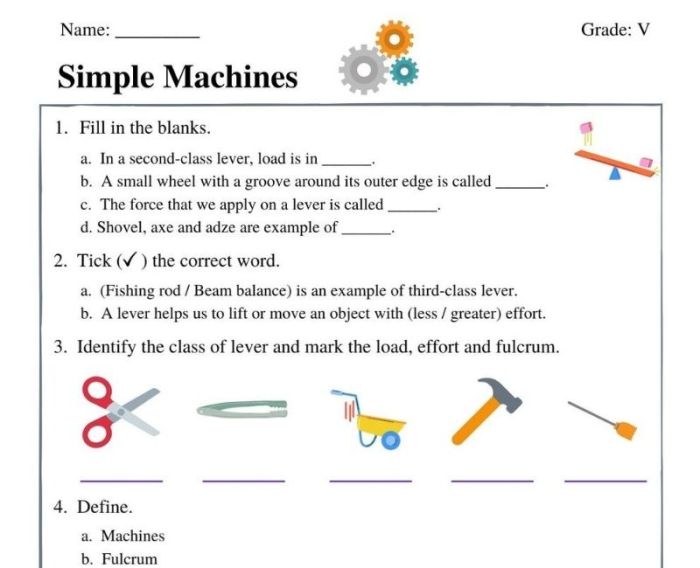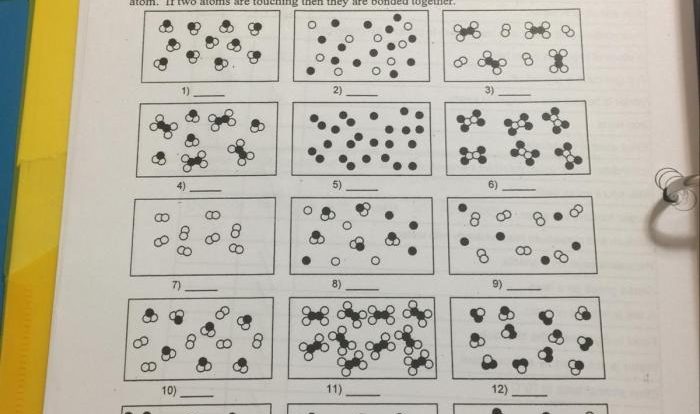Delve into the fascinating realm of simple machines with our comprehensive Simple Machines Webquest Answer Key. This meticulously crafted guide empowers you to grasp the fundamental concepts, types, and applications of these indispensable tools that shape our world. Prepare to embark on an enlightening journey as we unravel the intricate workings of levers, pulleys, inclined planes, wedges, screws, and wheels and axles.
Definition of Simple Machines
Simple machines are devices that change the direction or magnitude of a force. They are used in a wide variety of applications, from everyday tasks to complex industrial processes.
The six types of simple machines are the lever, pulley, inclined plane, wedge, screw, and wheel and axle. Each type of simple machine has its own unique characteristics and functions.
Types of Simple Machines

Lever, Simple machines webquest answer key
A lever is a rigid bar that pivots on a fixed point, called a fulcrum. The input force is applied to one end of the lever, and the output force is applied to the other end.
Levers are used in a wide variety of applications, including撬动物体、切割物体和抬起重物。
Pulley
A pulley is a wheel with a grooved rim. A rope or cable is passed through the groove, and the input force is applied to one end of the rope or cable. The output force is applied to the other end of the rope or cable.
Pulleys are used in a wide variety of applications, including lifting objects, changing the direction of a force, and creating a mechanical advantage.
Inclined Plane
An inclined plane is a sloping surface. The input force is applied to an object that is on the inclined plane, and the output force is the weight of the object.
Inclined planes are used in a wide variety of applications, including moving objects from one level to another, creating a mechanical advantage, and reducing friction.
Wedge
A wedge is a triangular-shaped object that is used to split objects apart. The input force is applied to the thin end of the wedge, and the output force is applied to the thick end of the wedge.
Wedges are used in a wide variety of applications, including splitting wood, cutting paper, and prying objects apart.
Screw
A screw is a spiral-shaped object that is used to hold objects together or to move objects from one place to another. The input force is applied to the head of the screw, and the output force is applied to the threads of the screw.
Screws are used in a wide variety of applications, including fastening objects together, creating a mechanical advantage, and moving objects from one place to another.
Wheel and Axle
A wheel and axle is a combination of a wheel and an axle. The input force is applied to the wheel, and the output force is applied to the axle.
Wheels and axles are used in a wide variety of applications, including moving objects from one place to another, creating a mechanical advantage, and changing the direction of a force.
Mechanical Advantage and Efficiency
Mechanical Advantage
The mechanical advantage of a simple machine is the ratio of the output force to the input force. The mechanical advantage of a simple machine is determined by the design of the machine.
The mechanical advantage of a simple machine can be used to amplify force, change the direction of a force, or move objects from one place to another.
Efficiency
The efficiency of a simple machine is the ratio of the output work to the input work. The efficiency of a simple machine is always less than 100% because some of the input work is lost to friction and other factors.
The efficiency of a simple machine can be improved by reducing friction and other factors that cause energy loss.
Applications of Simple Machines

Simple machines are used in a wide variety of applications, including:
- Construction
- Transportation
- Manufacturing
- Everyday life
Simple machines have played a major role in the development of human civilization. They have made it possible to build bridges, move heavy objects, and create complex machines.
Simple machines continue to be used in a wide variety of applications today. They are essential to our modern world.
Question Bank: Simple Machines Webquest Answer Key
What is the primary purpose of a simple machine?
Simple machines are designed to make work easier by altering the direction or magnitude of a force.
Name the six types of simple machines.
The six types of simple machines are: lever, pulley, inclined plane, wedge, screw, and wheel and axle.
How is mechanical advantage calculated?
Mechanical advantage is calculated by dividing the output force by the input force.

